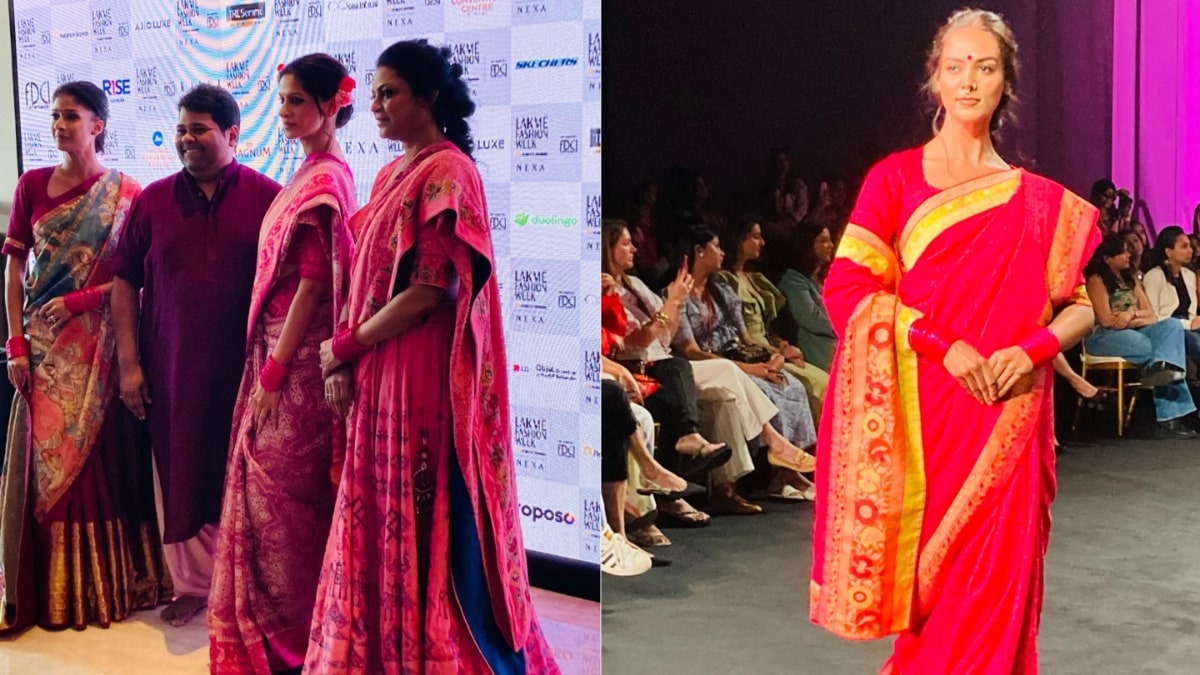Fashion designer Gaurang Shah has always believed in the art and culture of India. A few months back on a trip to Hyderabad, Vizag and Ponduru in Srikakulam district of the Indian state of Andhra Pradesh, Gaurang introduced us to the beautiful weaves of India.
For
Gaurang, India’s textile heritage is a rich legacy that reflects our culture, traditions, and history. The variety of weaves, from the intricate Jamdani to the vibrant Bandhani, tells stories of regions, communities, and generations of skilled artisans.
He says, “My work revolves around preserving these ancient crafts while ensuring they adapt to contemporary needs. By working directly with weavers, we focus on enhancing their skills, introducing them to new designs, and ensuring their art reaches a global audience. This not only sustains their livelihood but also keeps our textile heritage alive and evolving. Today, my family of weaves have grown to more than 900 weavers across India from Andhra Pradesh to Telangana to Benaras, Kashmir, Rajasthan, Gujarat and the North East.”
Talking about revival of weaves, he explains that the revival of traditional weaves is essential, not just as a nod to our past but as a path forward. Many of these crafts were on the brink of extinction due to industrialization and the fast fashion trend. By reviving these weaves, we are reclaiming our cultural identity and providing artisans with sustainable employment. This revival is not just about reproducing old designs; it’s about innovation within tradition, creating something that resonates with today’s world while staying true to its roots.
Edited experts from the interview:
How local are we getting when it comes to fashion?
There’s a growing appreciation for locally made, handcrafted textiles. Consumers are increasingly valuing the uniqueness and story behind each piece. This shift towards ‘local’ in fashion is not just a trend; it’s a movement that supports artisans, preserves our heritage, and promotes sustainable practices. When you wear a handloom saree or a piece of Jamdani, you’re not just wearing a garment; you’re wearing a piece of art, a piece of history.
What do you have to say about the business of fashion? Has it improved now that the pandemic is over and things are looking up in the last few years?
The business of fashion has seen significant changes post-pandemic. There’s a renewed focus on sustainability, conscious consumption, and the importance of supporting local crafts. While the industry faced challenges during the pandemic, it also opened up opportunities for introspection and change. The past two years have shown us that fashion isn’t just about trends; it’s about values, ethics, and the impact we have on the world. As things improve, there’s a stronger emphasis on quality over quantity and on pieces that are timeless rather than fleeting.
What is your take on conscious consumption?
Conscious consumption is the need of the hour. It’s about making informed choices, understanding the impact of what we buy, and valuing the craft and effort that goes into creating each piece. For me, it’s not just about promoting handloom and traditional weaves; it’s about encouraging people to think about where their clothes come from, who made them, and the story behind each thread. When we consume consciously, we contribute to a more sustainable and equitable world. It also becomes a catalyst for a new generation of weavers to embrace the art.
Fashion vs. Style—what is your preference, and how do you see the difference?
Fashion is ever-changing, driven by trends and what’s in vogue at any given moment. Style, on the other hand, is personal and timeless. It’s an expression of who you are, your personality, and your heritage. I prefer style because it’s about authenticity and confidence. It’s about wearing something that reflects your character, the personality within, that makes you feel good, and that has a deeper meaning. For me, style is about connecting with our roots while embracing individuality.
Who is your favorite style icon from Bollywood, and how would you like to dress him/her up?
I have had the privilege of dressing some of Bollywood’s most stylish women, including Sonam Kapoor, Vidya Balan, Kirron Kher, and Taapsee Pannu. Each of them brings a refreshing dimension to handlooms, with their personality and deep admiration for weaves. One icon I’ve always admired is Rekha. Her timeless elegance and grace are unmatched. I dream of the day she adorns one of my sarees, perhaps a rich Kanjeevaram with intricate Jamdani motifs, blending tradition with a touch of modernity. Rekha’s style is the perfect canvas for showcasing the beauty of Indian textiles.
Who is your favorite style icon from Hollywood, and how would you like to dress him/her up?
Hollywood has its share of style icons, but if I had to choose, it would be someone like Naomi Campbell. Her powerful presence and bold choices make her an ideal muse for Indian textiles. I would love to see her in a statement piece like a contemporary Jamdani saree, with geometric patterns and vibrant colors, paired with minimalistic accessories to let the weave shine. Naomi’s style is all about making a statement, and Indian textiles have the depth and richness to do just that.

